If you’re in the mood for a strong brew of architectural hucksterism–a marketing effort disguised as deep theory–read this hilarious piece by Patrik Schumacher, partner of Uber-starchitect Zaha Hadid. In it, he heralds the advent of a new architectural style, important enough to succeed Gothic, Baroque, and neo-Classical. He calls it: Parametricism. What is Parametricism? Apparently little more than the blobs that one can produce with minimal effort on the computer.
The piece is swollen with near meaningless prose such as the following:
Parametricism is able to deliver all the components for a high-performance contemporary life process.
If anyone has any idea what that is supposed to mean, please contact me, as if I am missing any components for a high-performance contemporary life process, I would like to know.
Parametricism is supposedly the great unifier, bringing together all the strands of our culture’s tapestry, frayed by a century of Modernist movements and sub-movements. Schumacher brags that the Nordpark Cable Railway stations in Innsbruck accomplish this great feat:
No other style could have achieved this coincidence of adaptive variation to the different site conditions with genotypical coherence across those phenotypical variants.
At least, that’s what I can just make out in the foggy verbiage. I think anyone who hasn’t taken leave of his common sense can see at a glance, however, that the claim is totally false. The Nordpark railway stations represent yet another architectural fad, with no roots whatsoever in the culture. There is no content to read, other than the vapid reference to computer modeling introduced to us by Disney thirty years ago in the movie Tron.
Oddly, Schumacher states that Parametricism can only bring together those divergent strands with its powerful rhetoric if no one else is allowed to interrupt:
Parametricism’s crucial ability to set up continuities and correspondences across diverse and distant elements relies on its principles holding uninterrupted sway. The admixture of a post-modernist, deconstructivist or minimalist design can only disrupt the penetrating and far-reaching parametricist continuity.
So is Parametricism an irresistible force for unity or not? Or is this just a wildly over-the-top marketing ploy to corner the market?
The reverse does not hold, because there is no equivalent degree of continuity in post-modernist, deconstructivist or minimalist urbanism. In fact, parametricism can take up vernacular, classical, modernist, post-modernist, deconstructivist and minimalist urban conditions, and forge a new network of affiliations and continuities between and beyond any number of urban fragments and conditions.
I beg to differ. Only the classical and the vernacular, which are coherent with man’s nature, can restore a sense order. They’ve been doing so for thousands of years. And I use those terms not in the sense of style, but in the sense of principles which undergird the whole history of styles.
But there is more to the Parametricist “one style to rule them all” heresy:
It aims to establish a complex variegated spatial order, using scripting to differentiate and correlate all elements and subsystems of a design. [emphasis mine]
In other words, the job of the architect is not to apply his intelligence, his cultivation, and the lessons of his forebears to design an elegant, legible, and beautiful solution to a particular problem, but rather it is to formulate an algorithm which is universally applicable. The computer then crunches the numbers and out pops the design. Now if that is not reductivism at its most extreme, I don’t know what is. How can 2500 years of architectural tradition, the subtle demands of the artistic eye, and the limitless range of formal expression, be reduced to a few lines of code?
The answer is, it cannot. Schumacher’s advocacy of formulaic solutions to life’s problems is a dead end, and a sad testament to the state of architectural education today. Computers are wonderful things, there is no doubt about it, but they have their place. Technology is supposed to serve man, not the other way around. For the architect, there are no cheap substitutes for training, study, and practice.
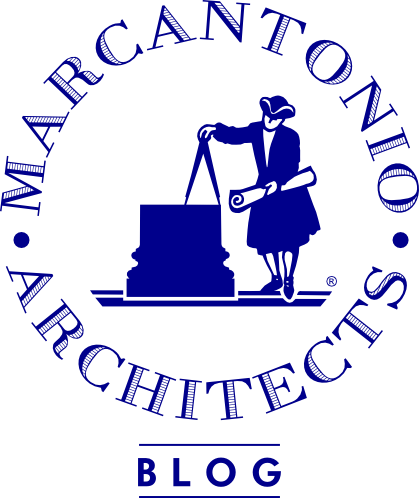
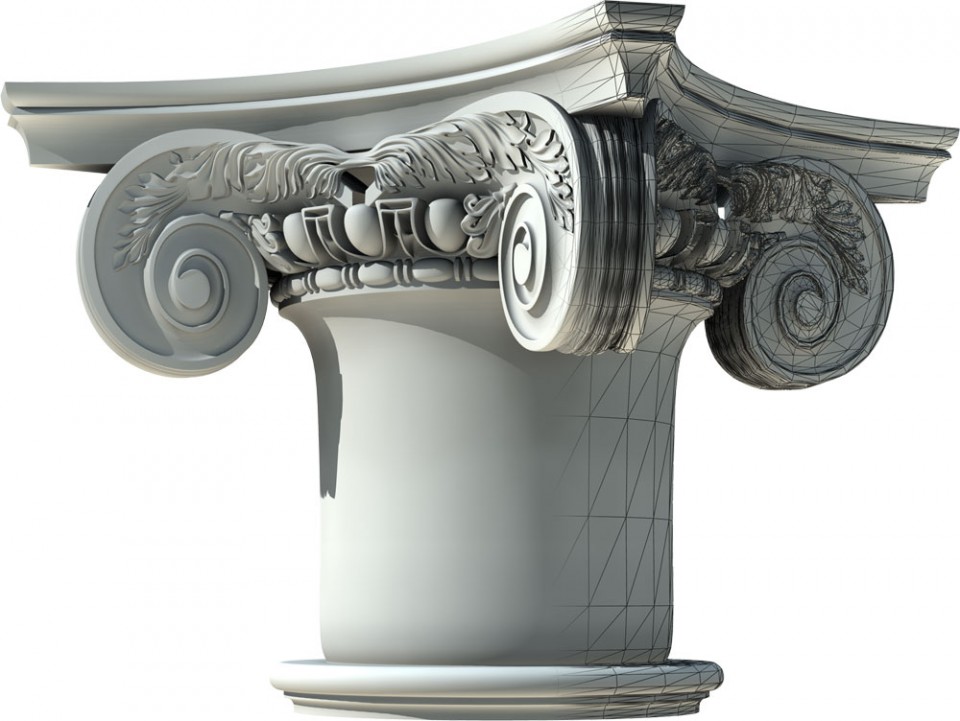
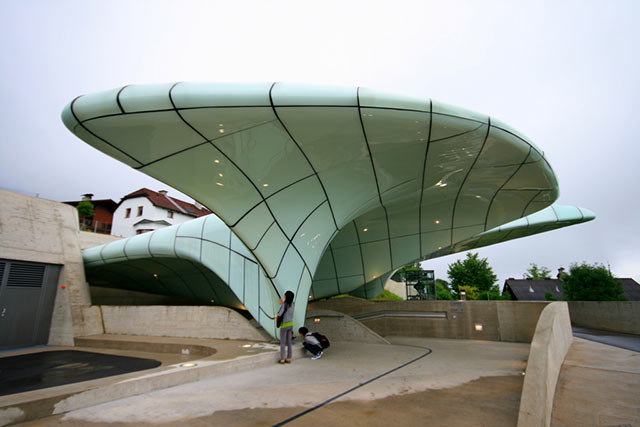

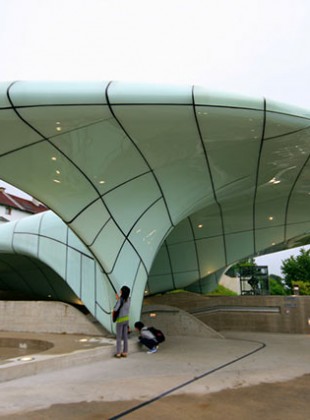
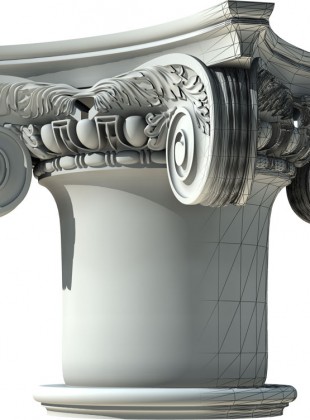
I’m just a person who enjoys the buildings that I enjoy and I’m willing to learn but… I thought they kept architecture students chained to their drafting tables and far away from critical theorists. Mr Hadid must have snuck out to the literature department. This was worse than reading an artist’s statement and made me feel stupid to boot.
I'm afraid even drafting is no longer taught with any rigor in the schools. Theory-speak is about the only thing the students master.
Is there a typographical error in Schumacher’s ‘manifesto’? Surely he meant, “Let the Star Wars begin”. What a sophisticated concept – a railway station that looks like a cross between the Millenium Falcon and the Starship Enterprise. It’s so “Ooh-la, edgy” in its contemporary curvacuity.
Your sanity and good taste are uncommon. I wish you well and look forward to visiting your page in the future.
“I’m afraid even drafting is no longer taught with any rigor in the schools. Theory-speak is about the only thing the students master.”Really? I mustn’t be studying architecture than. I guess I should pack it in?
First to the comment above Mr. Hadid is a Ms. Now that this is cleared up, I have to first say I am not an advocate of the computer initiated design, and I do agree that the language used is often ridiculous for the public, students of architecture, as well as architects themselves. However parametric design is a topic being addressed constantly it seems: where does it fit into our design process and how does it fit into our world in built form? Wherever you fall on this argument this doesn’t seem the place to discuss it. The post is sloppy, seemingly uneducated and unwilling to discuss the actual issues. If students need to know more than theory speak, then why don’t you, an educator, bring a more convincing thoughtful argument about how this type of architecture might impact our social/ cultural constructions within education and within actual practice. This is what is really disappointing and absurd about architecture today in my opinion.With love from Iowa.
The only people discussing parametricism are the opportunists and the gullible. It will have no lasting impact on the culture and will soon be as forgotten as the science of Phrenology. Don't waste your time. If you want to learn more than the art of theoryspeak, if you want to learn the art of architecture instead, then read the literature, starting with Vitruvius, and study the monuments, starting with the Egyptian.
A universal direction sets out a general prerogative , Clearly understanding what demarcates an elegant contribution to 21st century Architecture, A clear idea of what that is should always be in thought for the sake of the clients needs and wishes first and foremost. What is the most wonderful,state of the art thing that i can do that is not modernism that is not just another Post-modernity such deconstructivism.but is somthing new and relevant to the times.I fully support the ideas and values encompassed within most of his writings however maybe the name “parametricism” is wrong and only contributes but in a big way to some other universal direction.And the work he does is important, However my own universal values which i am currently writing helps to establish my own approach to projects. You can see my notes on my website these have not matured into a full blown essay as yet. The reason i do this is a sense of place in the world, Evaluating the current condition of architeture and having a positive content evaluation of the condition.Fluid diverse freedom and Diversism (ideals in parametricism although not named in this way ), provides a much needed reconnection to achieving clients needs more profoundly through efficiency. Providing a universal set of values, That are deep values that connect society and provide a diverse built environment for all, avoidance of segregation chaos, and segregated ghetos. Respectful of demographic core values of the locality. avoidance of individualism in terms of where The city becomes a collection of objects which demarcate their own taste or their identity not in the means of wholeness, But at the same time in support of individualism where individuals can contribute their own identity and contribution but to a deeper core set of universal values which contribute to the universal ecology of cities as a whole with interwoven relationships. I cant stress enough the importance of exploring and thinking about the possible future core universal realistic ambition values and design approach for the next 89 years. It is about real change for a better starting point for the next generation of architects.Patrick Schumacher can only be praised, and politely constructively criticized for his ideas to my mind.Luke
I am studying in London.Whilst my school does not teach the individual aspects of manual draughting, they preach it and encourage everyone to use this aspect over CAD programs.In tune with the article, one of my tutors, worked for Zaha Hadid practices for a large span on the timeline and highly preaches the CAD, and not to bother with the manual draughting. I agree with the former and i personally took it under myself to learn the blood sweat and joy version over CAD first because i felt like i needed to get to know this aspect of Architecture, as essentially it all started with these plans, for the large part anyway.It is being pushed out, not only by modern teachers but also by students who simple don’t see the point and cant be bothered, if certain people wish it to stay, then they must teach and preach it, explain the love and its worth, take the students to the V&A Architecture gallery too see the oh so beautiful plans!
And whilst i am on the desperate search for a Part 1 placement (albeit 2 years ahead of time) i am already sensing a case of dropping the pencil rather than being laughed at in a new office!I have heard many opposite stories regarding how practices view this though, ranging from the crazy “Is he attempting to do that by hand, the nutcase!” to the beautiful acknowledgement.
Read a book called The Craftsman, by Richard Sennett. Within the first 50 pages it makes a fantastic argument about CAD. But it also doesn’t try to rid us of these machines but very clearly explains our relationship to them. I personally want to be a human being that engages with the world instead of a drone so I have to set my path in that direction. Let them laugh.
Hi Dino.I ran across your post while searching for contemporary outdoor furniture. Go figure. Anyway, all the Classical Columns were specifically and intentionally “hard coded” in order to generate the beauty you think you see in these objects. These rules are why they appeal to your eye.Whether this is done with written rules that control your pencil lines or computer code that controls CAD lines seems rather irrelevant. Both are inevitably going to be put to use with poor execution by lesser talents.Most practitioners that are facile with parametric CAD would tell you that the Composite Capital you posted is a perfect example of something that can be generated parametrically.I realize this is a blog post but doesn’t it strike you as slightly ironic to state that his essay is “A piece that is swollen with meaningless prose” and then follow up with “Only the classical and the vernacular, which are coherent with man’s nature, can restore a sense order”? You seem to state that their practice lacks rigor which seems wildly off-base, no? I mean, ultimately you are really making an aesthetic argument against work that makes you uncomfortable.Surely you must question whether Vitruvius would have still written what he wrote if here were alive and writing today…Sincerely,Jon
Classical columns are not "hard coded." The rules for their composition are simply rules of thumb, like rules thumb for drawing the human figure (the head is approximately one eighth the height of the body, the tips of the fingers reach the middle of the thigh, the eyes are in the middle of the head, etc.). You learn these rules of thumb when you are a student. However, when you paint a scene, some figures will be proportioned heroically, others will be short and fat, and others will be tall and thin. Few will conform precisely to "the rules." Likewise, if you survey the history of architecture, you will notice that there is really an infinite variety of columnar proportions. Furthermore, columns are frequently tailored iconographically to suit their particular situations. The corn cob Corinthian columns of the U.S. Capitol are a famous example. Columns with real artistic value are not the product of hard coding–they are the product of difficult artistic judgment. I stand by my phrase "Only the classical and the vernacular, which are coherent with man's nature, can restore a sense order." I meant something fairly specific by it. I recommend you read my posts "Social Justice and Architecture," "Traditional Architecture FAQ," "I Refute Modernism Thus!" and the posts on the natural laws of architecture to find out more. You will see that I am not making an aesthetic argument against Parametricism, and I am certainly not dealing with discomfort. I am pointing out the evident flaws in the reasoning.
DIno.This is exactly the point. Parametric form generation and scripting are no more hard coded than the generation of classical columns. All involve aesthetic decision-making, for good or ill.The other point that strikes me is that your argument is as “fomulaic” as you argue Patrik’s is. At least he has the advantage – in my opinion – of making a progressive argument responding to contemporary society and contemporary technologies. When you use terms such as “vapid reference”, “minimal effort”, “out pops the design”, “few lines of code” etc, etc – you demonstrate a lack of respect for the work that belies an ignorance of the process (all of the process) in addition to a bombastic approach – which after all is what you appear to hold against the original essay.I would argue in favor of discussing the work and not attacking the messenger, as this seems like an unproductive discussion. Or at least discuss the approach and the process of the work in an architectural manner.Again, I find references to Vitruvian perfection to be awfully anachronistic and I have a hard time imagining a guy of his intelligence not being influenced by – or at least taking full advantage of contemporary tools. In fact, I’d argue you’d find a guy like Vitruvius in much more of a forward lean (similar to Schumacher’s) than engaged in any sort of retrograde, historicist, pursuit of aesthetic “perfection” – that was supposedly achieved generations ago. [You want me to build /what/ (?!) out of plastic molding, sheetrock and paper thin stone facades?] In fact, if you want to make an argument that is rooted in history (or “natural laws”?), you could very well argue that the parametric tools and the computer now allow one to create architecture with another kind of historical logic – that of Projective and Constructive Geometry – which was left behind (for a variety of reasons) in favor of Durand’s static plan typologies and Vitruvian perfection.Indeed, Stereotomy, Stone-Cutting and Projective Geometry may have more in common with Parametric Architecture – and thus in /actual/ building than perhaps you are aware. It strikes me as a slightly fascistic argument to say that the work is “little more than blobs that one can produce with minimal effort on the computer”.I mean, I respect the fact that you are calling out the essay as being slightly “muscly” and “girded” as it steels itself for the battle ahead, but what I am saying is that I would have more respect for your response if you – say -enlightened us on the /actual/ construction techniques of the “corn cob” Corinthian Columns of the US Capitol (which you cite) and transposed this agains the construction techniques of Nordpark Railway.Maybe then we could start to discuss the “rigor” which you appear to hold in high esteem.Regards.Jonathan
"Parametricism" is regress, not progress. It is not going to make a more beautiful world or a more just world. As for contemporary technologies, modern traditional architecture responds robustly, and more appropriately. It incorporates the best construction technologies, and the best building control technologies, without relying uniquely on technological iconography for symbolic expression. The Greco-Roman tradition, of which Vitruvius is a part, has always taken full advantage of contemporary tools. The tradition has never been about the mere copying of a "perfect" model produced thousands of years ago. It is about doing the best we can with the lessons taught to us by our forebears and the circumstances given to us, and when circumstances permit, doing better than our forebears have done. To be rooted in history, you have to do more than simply be present sequentially. Stereotomy has only the most superficial connection to "Parametricism" as the point of stereotomy was to give stone-cutting symbolic purpose. I can discuss the work, but the point of this post was to discuss the manifesto (of which Mr. Schumacher is the author, not the messenger). I would also be happy to discuss construction techniques and their coherence with appearances, but Schumacher makes no mention of them.
Dino,This seems confused to me.The point of Stereotomy is not to give “symbolic meaning” to stonecutting, it is the way you make stonecutting work. It is the /essence/ of stonecutting. Just like many of the forms you see – and think are ‘blobs” that anyone can make – are the result of the same kind of underlying construction techniques, logic and technologies.We are in 2011 for god’s sake. What exactly does “technological iconography” mean? You mean it is glass? Or it has steel in it? Or it curves or angles? Words like “better world”, “just world”, “coherent with man’s nature” and “restore a sense of order” – I mean this gives me the /heebie/ /jeebies/ when you use them to dictate to others what architecture should look like.Recommending that a 19 year old kid should be reading Vitruvius instead of Schumacher – – I mean it’s like we’re learning Latin or something! Starts to sound like the Nun will get out the wooden ruler next. Do you drive a T-Model ford because it has “real artistic value”?The point I am making is that you are basically critiquing the /look/ of Patrik’s buildings based upon his /writing/ with the same kind of “foggy verbiage” and “swollen prose” that you are accusing him of using. Then you recommend an aesthetic that you prefer (“only the classical and the vernacular” etc, etc). I am saying he has the advantage of making a progressive statement /and/ he has the advantage of using contemporary techniques in an intelligent way that brings them all together.You on the other hand are referring to a column that not only do you have little idea of how to build, you cannot possibly imagine someone out in the hot sun building it. If you insist on making this happen the way you think it should look, you will resort to trickery using sheetrock, flexible plastic moldings and cast rodent turds with a large dollop of plastic binder.Do you honestly think Vitruvius would be out there drawing stone columns to cut and hew out of solid stone or asking the contractor to jerry-rig some kind of plastic-plaster-turd knock off?I mean, the Egyptian monuments are great and all but do you really have to go back to ancient Egypt to find architectural meaning and are you seriously putting this up as a model against the work of Hadid and Company? Or the “vernacular”? What on god’s green earth is the vernacular these days?From Michael Sorkin – “Ugly is what the fearful call the new”. Or for the more impressionable reading the blog (also from Sorkin – “…why this nervousness in front of teacher when it would be just better to have fun? Here’s a formula for judging architectural results: that’s the way uh-huh uh-huh I like it”. Regards,Jonathan
Someone is indeed confused. Put down Schumacher and pick up Vitruvius and the rest of the classic architectural literature.
I’m not defending Mr. Schumacher’s points. Nonetheless, it seems your response runs toward the hyperbolic as well. His views on the subject, at least the nuggets you’ve pulled, tend toward opaque theory-speak and offer a very singular view of the subject. But it seems in your criticism, there is no differentiation between Mr. Schumacher’s views and the underlying trend toward algorithmic design.While algorithmic design, perhaps as practiced by Hadid’s office, may be used to derive style, this is not its only purpose. In fact, I would argue, it is not its main purpose or the purpose which will endure. Rather, there are a multitude of design and analysis methods and tools now used and in development that offer more sophisticated ways to model information when designing buildings. There is value in this trend, questions of style aside. We now try to design buildings such that we can correctly predict energy consumption, envelope performance, air quality, human comfort and productivity. Such predictions require the capacity to model the building to a level of detail not previously required. Algorithmic tools are a fundamental step in this direction — modeling the program and the design so that we may test the degree to which the design addresses the program.Architecture is not alone in incorporating algorithmic methods. The designers of everything from tooth brushes to airliners have incorporated or are incorporating similar techniques in their respective design fields because they are useful for managing risk and complexity and testing whether the design will likely accomplish its stated goals. In the sense that this shift in our profession is symptomatic of a larger trend in information modeling and management in design and engineering fields, there is an underlying market reality with which architects and designers must come to terms. To the extent that this trend exists to predict and verify performance and better manage risk, being dismissive of it is against one’s own interests as a professional.Having said that, most of my point so far is about design validation, not about aesthetic design. I do think Mr. Schumacher is suggesting that these same methods are useful aesthetic design tools, but he takes this proposition to a polemical extreme. You rightly point out that there is a nuanced, acquired judgment that designers exhibit that algorithms are not even close to being able to replicate. The designers’ senses, intuition and expertise cannot be supplanted by computations or parametrics at this time, or for the foreseeable future, perhaps not ever. In addition, it could be argued that design has always supplemented itself with the latest available parametric modeling techniques of the day, whether that be scripting or 2 point perspective, and that Mr. Schumacher is drawing an artificial distinction around the current manifestation of this aspect of the profession and discounting the degree to which all design practice already incorporates parametric techniques as needed.I will support one of the implied dimensions of Mr. Schumacher’s argument in favor of these methods and tools supporting aesthetic design. As opposed to some styles whereby, arguably, the designer is attempting to impose a theoretical order on a design when it may have little relevance to the actual needs of the users or client, the parametric approach to design does, at the minimum, make the design the pure product of addressing concrete programmatic and contextual needs. Importantly, the techniques used by Mr. Schumacher’s office embody the potential of modeling and operationalizing information on a vast scale at a fine granularity. With such techniques, it is possible to ground the design in the practical goals of the project and offer a glimpse at some of the gross forms and spatial arrangements that likely best address the program in ways not previously possible. Having said that, the resultant forms are still a far cry from design. Rather, the designer may consider them as spatial and formal checks — perhaps next-generation interactive parti diagrams — against which any design may be compared to ensure that it is not violating the basic provisions of the program.Finally, in seeking to ground my position in the literature of our field, I refer you to Alexander’s, Notes on the Synthesis of Form, and Geoffrey Scott’s, The Architecture of Humanism. I reference the former to show that for at least fifty years, designers have confronted the probability that the programmatic challenges and the ways in which we build now depend on policies, materials and methods that change rapidly enough that we do not amass sufficiently developed, tacit, professional mechanisms for assuring good design. That is, professional practice does not evolve fast enough in industrialized societies to keep pace with technological change. Thus, our designerly instincts may not suffice when assessing the likely performance or efficiency of a building serving a purpose, built within a context or with methods or materials for which we do not have adequate perspective based upon accumulated experience. As a result, we may need new tools or methods, as Alexander pointed out in the 60’s, that allow us to design good buildings even if we do not have tacit knowledge of the quality of environments such buildings will yield. The second reference (to Scott) is in support of your criticism of Schumacher’s polemical view of algorithmic design as the main driver of formal and spatial design. As per Scott, quality design does not follow rules or frameworks in any straightforward, literal way. Rather, frameworks can be useful as scaffolding for design, or to helpfully constrain the problem space, but they cannot stand in for good design. In extending Scott’s argument about fallacies to which architects tend to naively subscribe, such as the mechanical fallacy or the romantic fallacy, I suggest you may add the ‘parametric fallacy’, as described by Schumacher, in which the design can somehow be specified — a reductionist view — as the product of scriptable programmatic constraints.